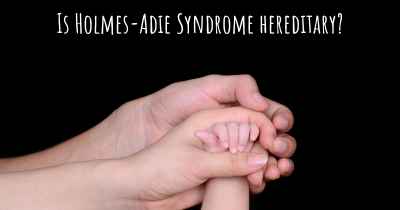What is the history of Holmes-Adie Syndrome?
When was Holmes-Adie Syndrome discovered? What is the story of this discovery? Was it coincidence or not?

Holmes-Adie Syndrome:
Holmes-Adie Syndrome, also known as Adie's tonic pupil or Adie's syndrome, is a rare neurological disorder that affects the function of the autonomic nervous system. It was first described by Gordon Morgan Holmes in 1931 and later by William John Adie in 1932. This syndrome primarily affects the pupil of the eye, causing it to become dilated and unresponsive to light.
Discovery and Early Observations:
The history of Holmes-Adie Syndrome dates back to the early 20th century when Gordon Morgan Holmes, a British neurologist, first encountered patients with this peculiar condition. Holmes initially observed patients with dilated pupils that reacted slowly to light and accommodation. He described this phenomenon as "tonic pupils" and noted that it was more common in young women.
A year later, William John Adie, an Australian neurologist, independently reported similar cases and expanded on Holmes' observations. Adie noticed that the affected pupils also exhibited a slow constriction in response to near vision, a condition known as "tonic accommodation." He further characterized the syndrome by identifying associated symptoms such as absent or diminished deep tendon reflexes.
Clinical Features and Diagnosis:
Holmes-Adie Syndrome is characterized by a combination of symptoms, including a dilated pupil (mydriasis) that reacts slowly to light (tonic pupil), reduced or absent deep tendon reflexes (hyporeflexia or areflexia), and impaired near vision accommodation (tonic accommodation). These symptoms are typically unilateral, affecting one eye, but can occasionally be bilateral.
The diagnosis of Holmes-Adie Syndrome is primarily based on clinical examination. The affected pupil is usually larger than the normal pupil size and reacts sluggishly to light. The constriction of the pupil in response to near vision is also delayed. Deep tendon reflexes, such as the knee jerk reflex, are often absent or diminished. Additional tests, such as pharmacological testing with dilute pilocarpine, may be performed to confirm the diagnosis.
Pathophysiology:
The exact cause of Holmes-Adie Syndrome is unknown, but it is believed to result from damage or degeneration of the postganglionic parasympathetic fibers that innervate the pupil and ciliary muscles. This damage is thought to be caused by a viral or bacterial infection, trauma, or an autoimmune response. However, the underlying mechanism remains unclear.
Prevalence and Prognosis:
Holmes-Adie Syndrome is considered a rare disorder, with an estimated prevalence of 1 in 1,000 individuals. It typically affects young adults between the ages of 20 and 40, with a higher incidence in females. The condition is usually benign and does not significantly impact vision or overall health. However, some individuals may experience symptoms such as blurred vision, difficulty focusing, or light sensitivity.
Treatment and Management:
There is no specific cure for Holmes-Adie Syndrome, as it is a chronic condition. However, most individuals do not require treatment unless they experience bothersome symptoms. In cases where near vision is affected, reading glasses or bifocals may be prescribed to improve focus. Pilocarpine eye drops can also be used to constrict the pupil and improve light responsiveness.
Conclusion:
Holmes-Adie Syndrome, also known as Adie's tonic pupil, is a rare neurological disorder characterized by a dilated and unresponsive pupil, reduced deep tendon reflexes, and impaired near vision accommodation. It was first described by Gordon Morgan Holmes and later expanded upon by William John Adie. Although the exact cause and mechanism of the syndrome remain unclear, it is generally considered a benign condition that does not require treatment unless symptoms are bothersome. Further research is needed to better understand the underlying pathophysiology of Holmes-Adie Syndrome.








